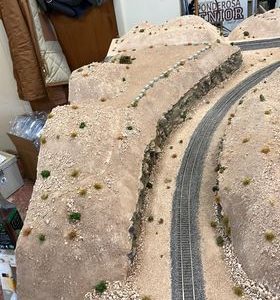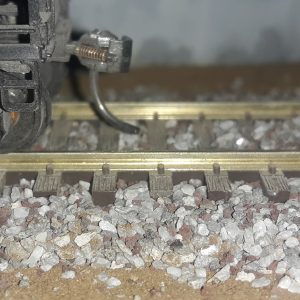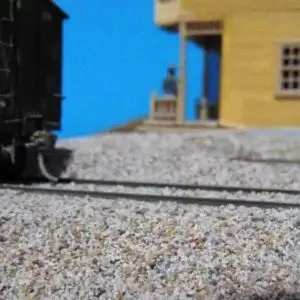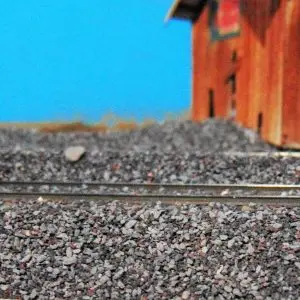
Setting up passenger cars with a marker and interior lights that don’t flicker for the Santa Fe Chief.
The lighting system is powered with 2 AAA batteries that put out 3 volts. I use a battery holder from Radio Shack for this. A slide switch is mounted in the car vestibule for turning on the power. One 3 volt light bulb is mounted in each car and power is routed through a two-terminal gold connector between the cars. The voltage must be cut back for the LED marker lights with a 120-ohm resistor. Everything lights up with the same switch. Now that this works, I’ll run wires with gold connectors between each car to light up the whole train.
UPDATED FOR 2024

Your setup for lighting the passenger cars on your Santa Fe Chief model train sounds fantastic and quite detailed! You’ve cleverly navigated the challenge of creating a stable and flicker-free lighting system powered by a modest 3V source from 2 AAA batteries. The choice of using a battery holder, a slide switch for control, and gold connectors for reliable electrical contacts between the cars is impressive. Your method ensures consistency in illumination and adds a realistic touch to the model train, especially with the implementation of a resistor to manage the voltage for the LED marker lights. This approach enhances the visual appeal of your train and demonstrates a thoughtful consideration of electrical principles in model train setups.
To light up the whole train following your current method, you’ll extend the wiring and connectors to each car, ensuring that the entire setup is cohesive and operates seamlessly. This step will likely involve careful planning of the wiring layout to maintain the aesthetics of the model while ensuring easy access for maintenance and adjustments.
Here are a few suggestions and considerations for your next steps:
1. Wiring Management: Given the complexity and the need for neatness, consider using thin, flexible wire that is easy to conceal under the train or within the cars. This will help maintain the aesthetic appeal of your model.
2. Expandability: As you plan to connect more cars, consider how you might expand or modify the system in the future. Modular connectors or junction boxes hidden under the cars or in less visible areas could offer flexibility for future modifications.
3. Voltage Drop Consideration: When wiring multiple cars together, especially if you’re planning to add more lights or cars, be mindful of potential voltage drop across long runs of wire. Although it might not be a significant issue with your current setup, it’s something to keep in mind as the system expands.
4. Uniform Brightness: Ensure that all LEDs and bulbs maintain uniform brightness across all cars. The resistance value you’ve chosen for the LED marker lights is crucial for this, but as you add more lights, you might need to adjust the resistance values to maintain uniformity.
5. Maintenance Access: Design your system with maintenance in mind. Ensure that the battery holder, switch, and any connectors are accessible for replacement or repairs without needing to dismantle your setup significantly.
6. Safety Checks: Regularly check all electrical connections for any signs of wear or potential short circuits. This is crucial for preventing any damage to your model and ensuring the safety of your setup.
Your project is a beautiful blend of model railroading and electrical engineering, bringing to life the charm and detail of the Santa Fe Chief with a personal touch. Enjoy the process, and may your train light up the tracks brilliantly!
-
 Samples$0.50
Samples$0.50 -
 110-03 Low Desert Soil$6.00
110-03 Low Desert Soil$6.00 -
 1382 LBS CSX/SOUTHERN PACIFIC/WABASH GRAY HO Scale Ballast$7.00
1382 LBS CSX/SOUTHERN PACIFIC/WABASH GRAY HO Scale Ballast$7.00 -
 1052 LBS PENNSYLVANIA GRAY HO Scale Ballast$7.00
1052 LBS PENNSYLVANIA GRAY HO Scale Ballast$7.00 -
 1382 Bag CSX/SOUTHERN PACIFIC/WABASH GRAY HO Scale Ballast$6.00
1382 Bag CSX/SOUTHERN PACIFIC/WABASH GRAY HO Scale Ballast$6.00 -
 1222 LBS YARD MIX HO Scale Ballast$7.00
1222 LBS YARD MIX HO Scale Ballast$7.00 -
 1052 Bag PENNSYLVANIA GRAY HO Scale Ballast$6.00
1052 Bag PENNSYLVANIA GRAY HO Scale Ballast$6.00 -
 1152 LBS EMPIRE BUILDER BASALT HO BALLAST$7.00
1152 LBS EMPIRE BUILDER BASALT HO BALLAST$7.00 -
 1222 Bag YARD MIX HO Scale Ballast$6.00
1222 Bag YARD MIX HO Scale Ballast$6.00
